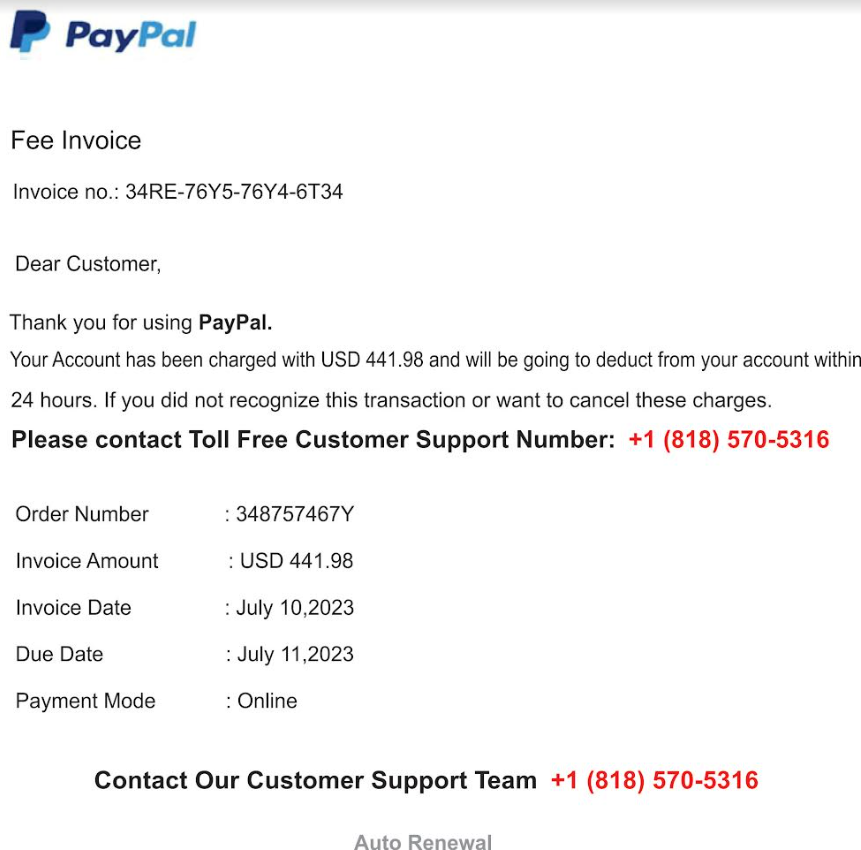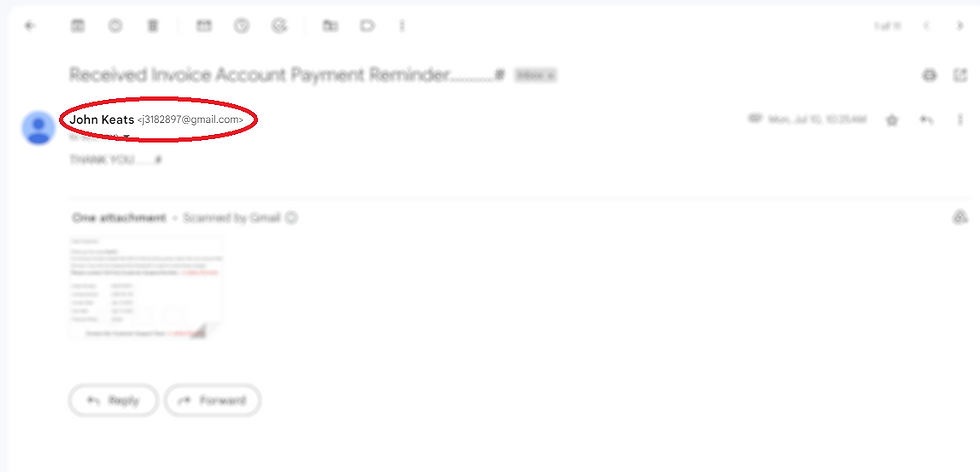We Have Been Trying To Reach You...
- fixitfremont
- Jul 25, 2023
- 6 min read
It's a Monday morning. I'm checking my email to start my week. I log in to see I have a new email from "John Keats". The subject line reads, "Received Invoice Account Payment Reminder..........#".
I will tell you I already knew this email was a scam, but I will continue.
I open the email to see it consists of the phrase, "THANK YOU.......#" and a single PDF attachment. I am now even more sure this is a scam email.
I open the attachment [FYI: DO NOT OPEN EMAIL ATTACHMENTS FROM PEOPLE YOU DO NOT KNOW AND TRUST!!!] and it reads as follows...

I could now not be more sure that this email is a scam! However, it isn't a complete waste, because now I can walk you through this scam email and give you some pointers for spotting them in your inbox.
Hint #1 - Who is John Keats?
I will admit, that's a pretty good title for a mystery novel, but definitely not something I should be asking first thing in the morning looking at my email. If you receive an email from someone you do not know, it's very likely a scam. Just right off the bat, keep that in mind. However, I run a business and expect to receive emails from people I don't recognize, so it is at least worth looking at with a wary eye.
As a side note, at the time of this writing, I have only recently started this business. I have not had any business with anyone that would require an invoice let alone an invoice reminder.
Furthermore, at no point in my life have I ever received a legitimate email with ten periods and the pound sign at the end. "..........#" is simply not the way to end a subject line. Hence my suspicion from the get go.
EVEN MORE FURTHER, this same excessive use of periods and arbitrary pound sign shows up again for no apparent reason in the body of the email. The odd and random nature of this writing style doesn't match any I've ever received from a company or individual.
Hint #2 - From Whence It Came.
When you clicked on the email you can see its contents, but you can also see the email address of whoever sent it to you.

A first initial and a last name, or a last initial and a company name, anything along those lines are perfectly normal emails to be coming from an organization. That's fine. This email: j3182897@gmail.com is not a legitimate business email address. It is in fact a suspicious email address.
Hint #3 - What's In The Box?!
So we aren't dealing with a box per se, but when we see an attachment, we want to know what it is? What did I receive? Is it important? Is it interesting? Does it have something to do with cats? So many questions! So much intrigue!
DO NOT OPEN ATTACHMENTS FROM PEOPLE YOU DO NOT KNOW AND TRUST!!!!!!!!!
This is one of the biggest ways people get junk on their computer. Just don't do it. Opening the email itself to see what it says is perfectly safe. You won't ever get anything nasty on your computer by simply opening an email. No worries there. However, if there is an attachment and you aren't 100% sure who it is from, just leave it alone! Clicking on the attachment will activate something. Opening an email is a neutral process. Opening an attachment is activating the attachment whatever it may be: video, audio, image, or malicious program trying to work it's way into your computer.
I recognized the attachment as a PDF file type. To me, I know that means it is a harmless image file (probably) that I can view safely. I won't say it wasn't entirely without risk, but it was an educated guess on a very low risk scenario.
All that being said, I opened the attachment and found the image I shared at the top of this list. I'll put it here again for reference.

I'll start by saying, if you owe someone money, they are going to make it clear so you definitely don't miss it. The fact that this "Fee Invoice" was sent as an attachment and there was no mention of it in the body of the email is weird. It would likely be bother.
Anyway!
I'm going to get a little picky here, but this attachment is full of red flags! I'm going to work my way from top to bottom and let you know what I saw. maybe you can pick out similar issues in scam emails you receive too.
1) PayPal logo. Not too bad so far, but it isn't very prominent and it isn't centered. Most often, companies really want you to know who they are. Their logos won't be so quiet and out of the way.
We'll call this an orange flag.
2) "Fee Invoice". What even is a "fee invoice"? It's just an invoice. The word "fee" is redundant.
The word excess here is a red flag.
3) "Invoice no.: 34RE-76Y5-76Y4-6T34". Just...all of this. Abbreviating "number" to "no." is fine, but right before a colon? It looks awkward. Big companies are going to have a firm grasp on English and writing aesthetics. Moving on, a sixteen digit alphanumeric invoice number is wildly unnecessary! When you buy a computer and first install Windows you will have to enter a sixteen digit alphanumeric activation key. A sixteen digit code using both numbers and letters is used for very secure passwords and activation keys since it gives you more than one hundred trillion possible combinations. Invoice numbers need to be unique, sure, but also easily recognizable, searchable, and repeatable. Again, this is an allegedly legitimate company that wants your money. They want that process to be clear and easy. Scammers want to confuse and complicate.
This provides two red flags.
4) "Dear Customer". Yeah, that looks fine. Good strong start to an email.
Or is it?!?!
While the start "Dear Customer," is standard and customary, notice that it is indented by one or two spaces in relation to the text that immediately follows. That is neither standard nor customary and is in fact fishy.
The formatting issue is a red flag.
5) "Your account has been charged with USD 441.98..." I do business in the US, I would expect the charge to be in USD. Why not just use "$" like everyone else? "...and will be going to deduct..." Just, no. "...from your account within 24 hours..." No, if I'm receiving a "Fee Invoice" that is something I have to pay actively. It isn't something that just gets removed from my PayPal or bank account. "...If you did not recognize this transaction or cancel these charges..." Proper grammar would be "If you do not recognize..."A transaction is something that has already happened. A charge is something that is going to happen. Also, this sentence is technically a fragment and would not end with a period.
Currency weirdness, grammar, wording inconsistency, and yet more grammar and wording issues adds up to five red flags.
6) "Please contact Toll Free Customer Support Number: +1 (818) 570-5316". Why is "contact" not also capitalized? The sentence as a whole is lacking an article (a, an, the, etc...). Toll free numbers start with either 800, 888, 877, 866, 855, 844, or 833. 818 is northern Los Angeles.
Also, PayPal's customer support number is 1 (888) 221-1161. You'll notice this is actually a toll free number.
Three more red flags.
7) Why do I have an invoice number and an order number? Why the continued use of USD and not $? Why does the formatting still not line up? Why do I have a due date if the money will simply be removed? Why use "Payment Mode" when everyone else says "Payment Method"? Why are the words "Auto Renewal" at the bottom of the image? Why are they grey? Why are they so close to the bottom?
Yeah, just too many red flags.
In conclusion................#
See what I did there?
1) Be picky! These companies, if they were really the ones trying to reach you, are professionals. They have professional writers and graphic designers on their teams just to send you a basic email. The emails will look and sound professional. Scammers are not professional. Emails from them will be full of weird little mistakes that just shouldn't be there.
2) Double check! Don't use the phone number provided. Just google it. Don't reply to the email, google the customer support contact information. Don't assume you're actually being charged, go check your PayPal account or call your bank. They will let you know any transactions that have happened or are scheduled to happen and they'll take care of it for you.
3) DON'T CLICK ON ATTACHMENTS OR LINKS!!! Just don't do it.
Worst case if you're ever not sure, ask someone you trust! Scammers thrive off panic and impending deadlines with scary sounding consequences. Just stay calm, keep a level head, and ask, "Is this reasonable?"
Stay safe and good luck out there!
Comentarios